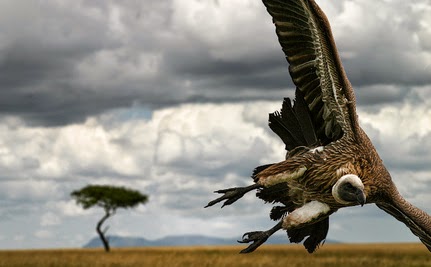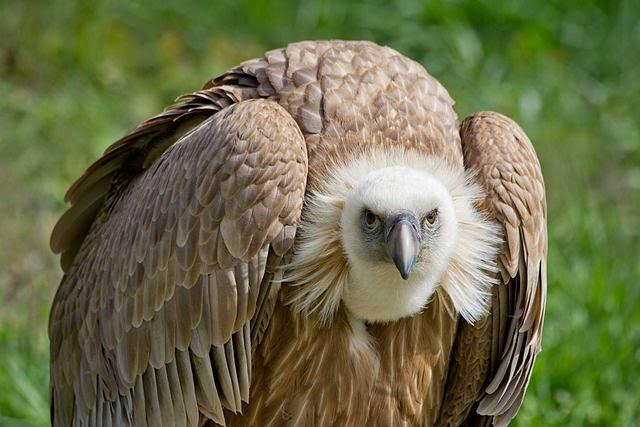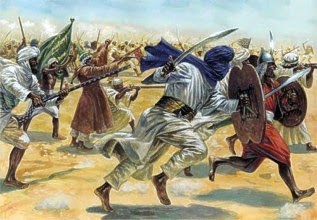Facts That’ll Make You Think Differently About Vultures
Poor vultures. They really get a bad rap. No one wants to be called a vulture. It means you’re lazy, just picking the scraps off someone else’s hard work. Vulture even became part of the 2012 presidential campaign vernacular. However, vultures are actually interesting creatures that play a vital role in their ecosystems.
There are 23 species of vultures that can be split into two groups: the New World Vultures and the Old World Vultures. On this International Vulture Awareness Day, let’s learn a little about these super gross and fascinating birds.
The source http://annamiticus.com says,
Vulture Fact 1: There are 23 species of “vultures”: 16 Old World vultures found in Africa, Asia, and Europe, and seven New World vultures (including the two condors) found in the Americas. (A list of vulture species is provided below.)
Vulture Fact 2: Old World and New World vultures are actually not closely related. However, because both groups perform highly specialized functions, they have developed similar biological traits.
Vulture Fact 3: Old World vultures do not have a good sense of smell – they rely exclusively on incredible eyesight to locate food – a soaring vulture can spot a 3-foot animal carcass from 4 miles away.
There are 23 species of “vultures”: 16 Old World vultures found in Africa, Asia, and Europe, and seven New World vultures (including the two condors) found in the Americas. Pictured: King vulture (Sarcoramphus papa).
Vulture Fact 4: Several species of New World vultures have a good sense of smell, unusual for raptors.
Vulture Fact 5: The Rueppell’s griffon vulture is the world’s highest flying bird. In 1973, one collided with an airplane off the Ivory Coast; at the time, the plane was flying at 37,000 feet.
Vulture Fact 6: Vultures can eat up to 20 percent of their own body weight in one sitting.
Old World and New World vultures are actually not closely related. However, because both groups perform highly specialized functions, they have developed similar biological traits. Pictured: California condor (Gymnogyps californianus).
Vulture Fact 7: Vultures are equipped with a digestive system that contains special acids that will dissolve anthrax, botulism, and cholera bacteria.
Vulture Fact 8: Vultures do not go after healthy prey, but will attack wounded and dying animals.
Vulture Fact 9: New World vultures have the unusual habit of urohydrosis — defecating on their legs to cool them by evaporation.
Vultures are equipped with a digestive system that contains special acids that will dissolve anthrax, botulism, and cholera bacteria. Pictured: Hooded vulture (Necrosyrtes monachus).
Vulture Fact 10: The bald, or lightly-feathered, head is specially designed to stay clean even when confronted with blood and bodily fluids present in the carcasses. Any remaining germs are baked off by the sun.
Vulture Fact 11: A group of vultures is called a venue, and when circling the air, a group of vultures is called a kettle.
Vulture Fact 12: By consuming the carcasses of diseased animals, vultures prevent the spread of life-threatening diseases such as rabies and anthrax among animals and humans.
Vulture Fact 13: Most vulture species mate for life.
A group of vultures is called a venue, and when circling the air, a group of vultures is called a kettle. Pictured: Rueppell’s Griffon Vulture (Gyps rueppellii)
Vulture Fact 14: The vomit of a vulture, followed by the action of flying away, is the most common defensive tactic against an adversary. If the food is relatively undigested, the predator is rewarded with a free meal. If the food is mostly digested, the foul-smelling substance acts as a deterrent and will sting the eyes of a predator if it lands in their face.
Vulture Fact 15: Most vultures are social and several species can often be seen feeding together on the same carcass.
Vulture Fact 16: One of the few animals to use tools, Egyptian vultures use rocks to break open ostrich eggs
OTHER SOURCE SAYS http://birding.about.com
- Vultures have relatively weak legs and feet with blunt talons, though they do have powerful bills. If a carcass is too stiff for them to rip open, they will wait for another predator to open the flesh before they feed, which is why vultures are often seen in the company of other carrion-eating animals.
- A vulture’s stomach acid is significantly stronger and more corrosive than that of other animals or birds. This allows these scavengers to feed on rotting carcasses that may be infected with dangerous bacteria, because their stomach acid will kill that bacteria so it does not threaten the vulture.
- While vultures eat mostly dead animals, they are capable of attacking and will often prey on extremely sick, wounded or infirm prey, especially if food has been scarce and there are no carcasses nearby.
- It is a myth that vultures will prey on healthy livestock, but they are still regularly persecuted by farmers and ranchers who believe the birds to be a threat to their animals.
- Because vultures have weak feet and legs, they do not carry prey back to their chicks. Instead, they will gorge at a carcass and regurgitate food from their crop to feed their young.
- Vultures urinate on their legs and feet to help cool off on hot days, and their urine also helps kill any bacteria or parasites they’ve picked up from walking through carcasses to help keep the birds healthier.
- The Andean condor, found in South America, has the largest wingspan of any vulture in the world, with a spread of 10-11 feet when the bird extends its wings.
- The crow-sized hooded vulture is the smallest of these birds with a wingspan of only five feet. It is found sub-Saharan Africa.
- When threatened, vultures vomit to lighten their body weight so they can escape more easily into flight. Vomiting also serves as a defense mechanism to deter predators that may be threatening the birds.
- New World vultures lack a syrinx and are nearly silent. They do not have songs, and their typical vocalizations are limited to grunts, hisses and similar sounds.
- Vultures face many threats that are endangering their populations. Poisoning is the biggest threat to vultures, primarily from toxins or lead in the carcasses they eat. Other hazards include car collisions as they feed on road kill and electrocution from collisions with power lines.
- Scientists have begun to study vultures’ unique senses and abilities and are considering using the birds to help find bodies from crimes. Studying how a vulture finds a body and how quickly it can consume the body can be useful for forensic analysis.
- Vultures enjoy their own unique holiday, International Vulture Awareness Day, which is celebrated on the first Saturday of each September. The holiday is a way to raise awareness about these unique birds, and hundreds of zoos, aviaries, nature preserves and bird refuges worldwide participate each year with fun and informational activities about vultures.
Old World and New World vulture species
Old World vultures
- Eurasian Black Vulture or Monk Vulture, Aegypius monachus
- Lammergeier or Bearded Vulture, Gypaetus barbatus
- Palm-nut vulture, Gypohierax angolensi
- Griffon vulture Gyps fulvus
- Indian White-Rumped vulture, Gyps bengalensis
- Rueppell’s Vulture, Gyps rueppelli
- Long-billed Vulture or Indian Vulture, Gyps indicus
- Slender-billed Vulture, Gyps tenuirostris
- Himalayan Griffon Vulture Gyps himalayensis
- White-backed Vulture, Gyps africanus
- Cape Griffon, Gyps coprotheres
- Hooded Vulture, Necrosyrtes monachus
- Egyptian Vulture, Neophron percnopterus
- Red-headed Vulture, Sarcogyps calvus
- Lappet-faced Vulture, Torgos tracheliotus
- White-headed Vulture, Trigonoceps occipitalis
New World vultures
- Turkey Vulture, Cathartes aura
- Greater Yellow-headed Vulture, Cathartes melambrotus
- Lesser Yellow-headed Vulture, Cathartes burrovianus
- King Vulture, Sarcorhamphus papa
- American Black Vulture, Coragyps atratus
Condors:
- California Condor, Gymnogyps californianus
- Andean Condor, Vultur gryphus









Comments
Post a Comment